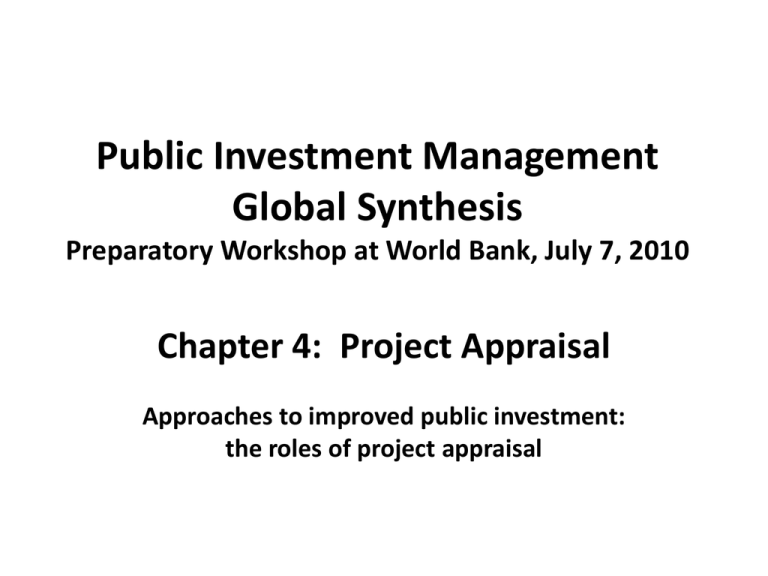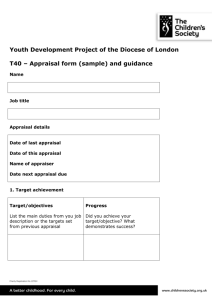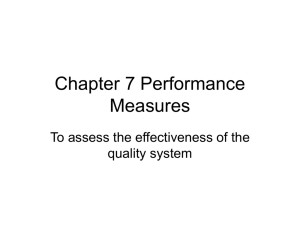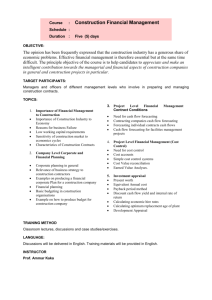Public Investment Management Global Synthesis Preparatory
advertisement

Public Investment Management Global Synthesis Preparatory Workshop at World Bank, July 7, 2010 Chapter 4: Project Appraisal Approaches to improved public investment: the roles of project appraisal Outline of Chapter 4 • Introduction • Project appraisal cycle and components • Effects of changing institutional arrangements in the organization and management of public sector on project appraisal • Integration of project appraisal in budgeting systems and the effects of budget reforms • What goes wrong and why? • Actions to improve role of project appraisal in capital budgeting (TBA) 1. Introduction • Importance of project appraisal – Project appraisal is a key tool to enhance wealth creation through designing, selecting and implementing public sector projects and programs with positive net benefits to an economy through providing public services directly to households or services that support private business operations. Achieved by • • • • Screening out bad projects (“white elephants” etc) Designing projects and programs along all its dimensions Ensuring proper costing and financing of investment phase Ensuring self-financing projects are financially viable and non-self financing projects will have adequate budget support over operational lives so that benefits of expected service delivery realized • Project risks are diversified or allocated to minimize costs • Equitable distribution of the gains and losses (gains to target poor, losses to resettled, gains to contractor or private partner?) • Basic failures and issues – Actual use of project appraisal by countries? Comparison with private sector – Demand driven appraisal in private and public sectors • Information about and forecasting of excess demand for public services: critical to project identification and benefit estimation • Demand for appraisal results to select and budget projects determines conduct of appraisal and is determined by institutional arrangements and budget systems of government 2. Project appraisal cycle & components • Identification of projects and programs – current or expected excess demand – sector demand information and models • Appraisal, review and screening of projects and programs – Components or modules of appraisal of a project 1. 2. 3. 4. 5. 6. Demand or market analysis Technical/engineering Organization, ownership, human resources and financing Financial analysis including internalized risks and environmental costs Economic analysis including external risks and environmental costs Distributional analysis – Basic criteria in project appraisal • Net Present Values (NPVs) and internal rates of return (IRRs) from financial and economic perspectives – Self-financing or commercial projects vs Non-self financing or budget supported projects – Targeted poverty alleviation projects 2. Project appraisal cycle & components (contd) – Stages of appraisal • Prefeasibility – screening and design issues • Feasibility – detailed appraisal • Detailed blue print – Level of effort in appraisal • Appraisal as a project – information and alternatives • Repetition and re-use of analysis – demand criteria – Special approvals critical to feasibility of project completion • Land access or allocation • Environmental approvals (forests, land reclamation, water, etc) • major social externalities such as loss of property rights by indigenous people, resettlement costs or job displacement 2. Project appraisal cycle & components (contd) • Budget authorization of services and appropriation of funding • Project implementation: procurement/contracting & monitoring – Construction phase – Operations phase • Ex post project or program evaluation 3. Effects of changing institutional arrangements in the organization and management of public sector on project appraisal • Core public sector organization – Finance and economic planning • • • • co-ordination and oversight traditional central planning approaches dual or integrated budgets decentralized planning & appraisal to operational ministries, authorities, sub-national governments, etc • Degrees of decentralization: Privatization, corporatization, concessions and regulation – Privatization with regulation (BOO) – Private participation with a time-limited concession (BOOT) – Private participation in building and operating facility leased by government (BLT) – Contracting out of specific services such as construction, management, operation or maintenance – Corporatizing a specific set of government functions – Sub-national governments 3. Organization and management of public sector (contd) • Roles of ministries of finance, economic planning and sector ministries – Sector ministries – sector planning and co-ordination; oversight of authorities and regulation – Economic planning • Macro planning and sector co-ordination • Sector legislation and oversight • Guidelines and methods – Finance • Budget system and project approval process • Revenue forecasting and O&M budget support • Outsourcing of project appraisal – Importance of guidelines, oversight and transfer of spreadsheet models • Donor agencies, international and other financial institutions – Conditions on project – Consistency in appraisal methods – Transfer of spreadsheet appraisal models 4. Integration of project appraisal in budgeting systems and the effects of budget reforms • Budget preparation, approvals, length of cycles, and scope – – – – Priorities & plans vs project identification process Two basic approvals Mismatch in time frames of budget/political and project cycles Time limited authorizations vs automatic or variable length authorizations – Dual vs integrated budgets • Effects of trends in budget reform on project appraisal – Medium term strategic budgeting – Performance budgeting and decentralization of management – Integrated budgets Table 4.1 Stages and Timing of Project Cycle and Budget Cycle Project Cycle Project stages Budget cycle Timing Budget stages Idea or definition Policy framework and strategic plan (medium term priorities and plans) Prefeasibility 1 Prior 1 to 10 years Detailed plan Construction or implementation Ex post evaluation Operation Ex post evaluation Termination or reinvestment Time 0 1-8 years 5-30 years forecasts) Approval in principle Strategic or medium-term budget for 3-5 years Detailed capital and current budget formulation 6 months before Finance and Budget authorization and appropriation legislation Time 0: End of prior financial year Budget approval Budget implementation Budget accounting, reporting & monitoring Audit of public accounts Evaluation of policies and programs 6-38 years 1 year before Macroeconomic and fiscal strategy (revenue and debt Feasibility 2 Timing Financial year Following year or years 5. What goes wrong and why? • Lack of excess demand data and forecasting models – Technical capacity gap – Lack of performance budgeting and management • Lack of demand for high quality design and project appraisal – Use input oriented budgeting (jobs, contracts, licenses, etc) rather than output oriented budgeting (enhanced service delivery) – Weak oversight and accountability • Lack of guidelines or conflicting guidelines – Undermines internal and external ability to conduct and oversee project appraisal. – Problem more serious the greater the degree of decentralization 5. What goes wrong and why? (contd) • White elephant projects – Excess capacity infrastructure – Capital investment of the project is completed, but little or no O&M funding is available over its operating life – Capital investment that never completed and abandoned • Change in political regime in cases of long gestation projects • Need variable length budget authorizations for long gestation projects • Delayed or excessively long construction period or excessive number of projects in budget relative to financial and management resources – Design, contracting or contractor problems – Failure to get prior approval for special approval items – Overloaded capital budgets – too many projects getting smaller allocations spread over longer construction periods • Poor performance in operational phase – Weak budget integration and failure to ensure budget support available for future O&M – Lack of performance monitoring and management • Lack of capacity – Lack of trained officials and/or lack of appropriate budget system to demand and support application of high quality project appraisal. – System capacity building is critical to effective training of officers and decision makers







